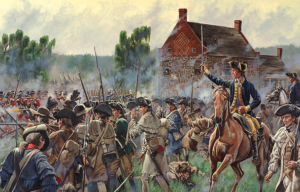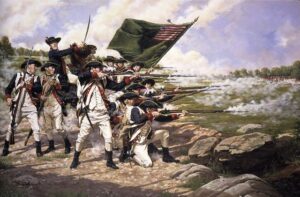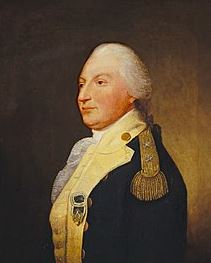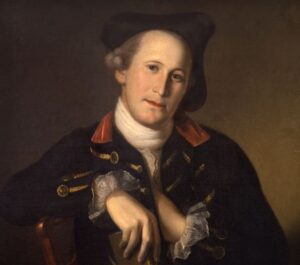
Painting of Maryland Regiment at Battle of Brooklyn by Mark Maritato
The following article was submitted by The National Society of the Sons of the American Revolution.
The National Society of the Sons of the American Revolution (NSSAR), founded in 1889, is a non-profit and non-partisan organization dedicated to promoting patriotism, serving our communities, and educating and inspiring future generations about the founding principles of our country.
Historic Anniversary for Battle of Brooklyn to Occur August 27, 2024
Two hundred and forty eight years ago, on August 27, 1776, George Washington’s Continental Army was saved from certain destruction by the Revolutionary War soldiers from Maryland who came to be known as the Maryland 400 and Washington’s Immortals.
Six months earlier, during March 1776, Washington successfully drove the British Army and Navy out of Boston, but knew they would soon return and likely try to conquer New York City.
The Continental Congress had given George Washington direction not to allow the British to take New York and he was determined to prevent that from happening. However, he also knew that it would be difficult, if not impossible, to defend New York and Long Island from the British because of its geographic location along the coast which played to the strengths of the Britain’s Navy. As a result, Washington’s army began to create a series of forts and defenses to protect New York City’s coastline and rivers.

Painting of the Delaware Regiment at Battle of Brooklyn by Dominick D’Andrea
The British Army returned in a few months and landed 30,000 troops on Staten Island during the summer of 1776 just across Gravesend Bay from Brooklyn on Long Island. Washington knew it would not be long before the British navy ferried thousands of troops to Manhattan or Long Island to attack his army. On August 22, 1776, the first way of 22,000 British troops came across Gravesend Bay.
British General William Howe and General Henry Clinton developed a plan to trap and destroy Washington’s Army. On August 27, 1776, Clinton sent General James Grant with 5,000 troops to attack the right side of Washington’s Army where they were dug in on the Gowanus Heights. Clinton also sent a group of Hessian soldiers to attack the center of Washington’s line. The goal was to keep the American Army occupied while Clinton secretly led a much larger force of 10,000 British soldiers through the Jamaica Pass, which was only guarded by a few men to attack Washington’s flank and crush his army.
Clinton’s plan worked as designed and soon Washington’s entire army was in real danger. The American troops were taking fire from both sides and so retreated into a marsh. They had to swim 80 yards across the Gowanus Creek to escape, survive, and make their way to the defenses the American troops had prepared on Brooklyn Heights. One obstacle standing in their way was an old stone house occupied by British commander Lord Charles Cornwallis and hundreds of British troops who were positioned there to destroy Washington’s Army as it fled through the marsh and attempted to cross the creek to safety.
Realizing the danger, about half of General William Smallwood’s Battalion under William Alexander, who was also known as Lord Sterling, made a suicide attack on the stone house to give his comrades time to escape. Cornwallis’ men fired muskets and light cannons into the approaching Maryland troops severing, limbs, heads and stopping Smallwood’s men in their tracks. Although this first assault failed, Alexander realized the Continental Army needed more time to escape so ordered his men to attack the stone house several more times. Alexander believed his men were close to driving the British soldiers from the house when numerous British reinforcements arrived.

Portrait of William Smallwood circa 1780 by Robert Edge Pine
After the Delaware and Pennsylvania’s lines collapsed the Maryland line led by Colonel Mordecai Gist was all that was left to cover the retreat of the American Army. About 260-270 Maryland troops were all that was left on the field. They were facing nearly 2,000 British soldiers. But they held the line long enough to cover the retreat of the remaining American troops. According to reports prepared after the battle, 256 Maryland soldiers perished that day.
Surrounded on all sides the remaining Marylanders led by Gist fought for their lives while trying to escape through the marsh. The British showed no mercy, killing or wounding many American soldiers, and took few prisoners. The Hessian soldiers were especially brutal, surrounding and then killing many of the American soldiers with their bayonets.
General Smallwood brought up two cannons on the opposite side of Gowanus Creek and fired toward the British troops to provide cover for Gist and the last few Marylanders who were swimming across the creek.
One young private, Joseph Plumb Martin, who kept a diary during the war, wrote “the men came up out of the water and mud, to us, looking like water-rats.” Many could not swim and suffocated or drowned.
As the day was drawing to a close, Clinton decided not to pursue the troops and attack the fortifications on Brooklyn Heights until the next morning. Had he done so, the American Revolution would likely have ended that day since much of the Continental Army would have been destroyed.
That evening Washington convened a council of his senior officers to determine their next move. Many thought it was unlikely they could evacuate the Fort on Brooklyn Heights and escape across the East River to Manhattan since the River was a mile wide and had swift currents. Some urged the General to stand, fight, and defend the fort. However, with his troops outnumbered by the British, Washington ordered a secret evacuation in the middle of the night. It would have been impossible to do so during the daylight hours since the British Warships could sail up the East river and prevent Washington’s Army from crossing the river. If the British discovered what was happening they would surely have attacked to prevent Washington’s Army from escaping. No one but a handful of Washington’s close circle of officers knew what was about to happen. His military units were sent one by one in the direction of the river but told only that they were going to conduct a night raid. In reality, his army of 9,500 men were going to be evaluated across the river.

Painting of Colonel Mordecai Gist by Charles Wilson Peale
Washington chose the remaining Maryland troops and a Delaware Regiment to serve as the rear guard to protect his army as it was being evaluated should the British attempt a night attack.
The task of moving Washington’s army across the River was given to Colonel John Glover and his Marblehead Mariners from Massachusetts who collected any boat they could find and secretly moved the entire army, horses, wagons, cannons and supplies across the East River in a single night.
When dawn arrived the American Army had not yet finished evacuating across the river but an unusual fog set in masking the evacuation. The Marylanders in Samuel Smith’s 8th Company, who were acting as the rear guard, were nearly left behind because Smith did not receive the order that it was his unit’s turn to leave. Fortunately, a lieutenant went to see why Smith’s company had not reported to the river and told him and his men to head their straight away. Smith’s company had just finished loading on the last boat when the British came over a hill and begin firing on them but did not cause any injuries. George Washington was in that last boat to leave the shore and cross the East River with the remainder of the Maryland troops.
George Washington credited General Smallwood’s Maryland Troops with saving the American Army during this battle. Standing next to Smallwood, George Washington watched the battle and witnessed what he called his “old line” defending his army and giving them the opportunity to escape destruction. Washington was visibly moved by the valiant action and sacrifice of the Maryland troops and said, “Good God! What brave fellows I must this day lose?” This is why Maryland earned the nickname the “Old Line State.”
The Battle of Brooklyn was a major defeat for Washington. In all, the American Army lost about 1,000 men killed, captured, or missing during that battle. However, the rest of Washington’s army escaped and lived to fight another day. Washington went on to win major victories against the British a few months later in Trenton during December 1776 and in Princeton in early 1777.
To learn more about the Maryland 400, read the book Washington’s Immortals: The Untold Story of an Elite Regiment Who Changed the Course of the Revolution by Patrick K. O’Donnell.
You can also watch a four-minute video titled The Battle of Brooklyn (Long Island) to learn more about battle at the following link: https://www.youtube.com/watch?v=aLdwq0XxOtI
Many members of the Maryland Society of the Sons of the American Revolution (MDSSAR) and their guests from Charles County and throughout the state of Maryland will make their annual pilgrimage to Brooklyn Heights, New York on Saturday August 24, 2024 to remember and honor General Smallwood, William Alexander, Mordecai Gist, the Maryland 400 soldiers who sacrificed their lives to save the American Army.
To learn more about the Colonel Tench Tilghman Chapter of the SAR, please go to the Maryland Society of the Sons of the American Revolution website at https://www.mdssar.org/ and the chapter’s Facebook Group page: https://www.facebook.com/ColTenchTilghman


